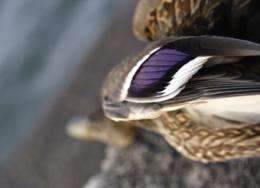High-maintenance mallards

The shimmery feathers of a male mallard might have a showy quality that appeals to prospective mates, but the water resistance and self-cleaning capabilities of iridescent feathers pale in comparison to those of noniridescent plumage.
"Those good looks come at a cost," says researcher Chad Eliason, a graduate student in The University of Akron Integrated Biosciences Ph.D. program. Eliason, along with principal investigator Dr. Matthew Shawkey, UA associate professor of biology, say mallards' patches of iridescent feathers have deficient water repellency.
The Journal of Experimental Biology selected Shawkey and Eliason’s research finding, "Decreased hydrophobicity of iridescent feathers: a potential cost of shiny plumage," as its Editors' Choice paper for the July 2011 issue of the journal.
Eliason explains that iridescent feathers achieve their color by light scattering from nanometer-scaled structures in the plumage. The flattened barbules of thesefeathers are twisted toward the plumage surface, causing them to reflect light in abundance, yet expose more surface area for water adhesion.
"The deeper the tone of the iridescent feather, the less its hydrophobicity," says Shawkey, adding that less water resistance not only results in damp, but also soiled feathers.
Pretty, not practical
Eliason and Shawkey exposed both dull brown and iridescent violet portions of feathers to water droplets and discovered that the brown plumage repelled water, which efficiently washed away dust. In contrast, vivid violet feathers retained more water, compromising their ability to self-clean.
The researchers add that their finding provides insight to the evolution and distribution of iridescent plumage in birds.
"Males may use iridescent colors to advertise to prospective mates their ability to survive despite potentially waterlogged feathers; then females could correctly choose high-quality males," says Shawkey. “These flattened barbules are found in iridescent feathers of many species, so this could be a widespread pattern. We hope to find out if this is true in future research."
Provided by University of Akron




















